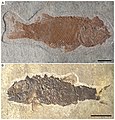Ginglymodi
| Ginglymodi Temporal range:
| |
|---|---|

| |
| Spotted gar (Lepisosteus oculatus) | |

| |
| Macrosemimimus fegerti (Semionotiformes) from the Upper Jurassic of Germany | |
| Scientific classification | |
| Kingdom: | Animalia |
| Phylum: | Chordata |
| Class: | Actinopterygii |
| Infraclass: | Holostei |
| Clade: | Ginglymodi Cope, 1871 |
| Subgroups | |
| |
Ginglymodi is a clade of ray-finned fish containing modern-day gars (Lepisosteidae) and their extinct relatives, including the family Lepidotidae and the orders Semionotiformes and , and various other extinct taxa. Ginglymodi is one of the two major subgroups of the infraclass Holostei, the other one being Halecomorphi, which contains the bowfin and its fossil relatives.[2][7]

| Neopterygii |
| ||||||||||||
Fossil record[]
The fossil record of ginglymodians goes back at least to the Anisian stage of the Triassic period, over 240 million years ago.[8] Eosemionotus is one of the earliest ginglymodians. Acentrophorus, another taxon from the Wuchiapingian stage of the late Permian, and Paracentrophorus from the Early Triassic epoch, could be even earlier members of the group. Ginglymodi was diverse and widespread during the Mesozoic era, but they represent a depauperate lineage today. Only six species exist today, distributed in freshwater systems of North America.

The Middle Triassic

The Jurassic macrosemiid semionotiform Propterus sp.

The Jurassic macrosemiid semionotiform Macrosemius rostratus
The Jurassic-Cretaceous lepisosteiform Scheenstia maxima
The lepisosteiform Atractosteus strausi from the Eocene Messel Formation of Germany

The lepisosteiform Atractosteus simplex from the Eocene Green River Formation of Wyoming
References[]
- ^ Xu, G.; Ma, X.; Wu, F.; Ren, Y. (2019). "A Middle Triassic kyphosichthyiform from Yunnan, China, and phylogenetic reassessment of early ginglymodians". Vertebrata PalAsiatica. 57 (3): 181–204. doi:10.19615/j.cnki.1000-3118.190319.
- ^ a b López-Arbarello, A.; Sferco, E. (2018). "Neopterygian phylogeny: the merger assay". Royal Society Open Science. 5 (3): 172337. Bibcode:2018RSOS....572337L. doi:10.1098/rsos.172337. PMC 5882744. PMID 29657820.
- ^ de Paiva, H. C. L.; Gallo, V. (2018). "Quasimodichthys gen. nov. (Neopterygii: Semionotiformes): A morphological and ontogenetic study". Journal of South American Earth Sciences. 88: 132–143. Bibcode:2018JSAES..88..132P. doi:10.1016/j.jsames.2018.08.010. S2CID 134986658.
- ^ Murray, A. M.; Xing, L.; Divay, J.; Liu, J.; Wang, F. (2015). "A Late Jurassic freshwater fish (Ginglymodi, Lepisosteiformes) from Qijiang, Chongqing, China". Journal of Vertebrate Paleontology. 35 (2): e911187. doi:10.1080/02724634.2014.911187. S2CID 85946657.
- ^ Deesri, U.; Jintasakul, P.; Cavin, L. (2016). "A new Ginglymodi (Actinopterygii, Holostei) from the Late Jurassic–Early Cretaceous of Thailand, with comments on the early diversification of Lepisosteiformes in Southeast Asia". Journal of Vertebrate Paleontology. 36 (6): e1225747. doi:10.1080/02724634.2016.1225747. S2CID 89359438.
- ^ a b López-Arbarello, A. (2012). "Phylogenetic Interrelationships of Ginglymodian Fishes (Actinopterygii: Neopterygii)". PLOS ONE. 7 (7): e39370. Bibcode:2012PLoSO...739370L. doi:10.1371/journal.pone.0039370. PMC 3394768. PMID 22808031.
- ^ Nelson, Joseph, S. (2016). Fishes of the World. John Wiley & Sons, Inc. ISBN 978-1-118-34233-6.
- ^ Romano, Carlo (2021). "A Hiatus Obscures the Early Evolution of Modern Lineages of Bony Fishes". Frontiers in Earth Science. 8: 672. doi:10.3389/feart.2020.618853. ISSN 2296-6463.
- Ginglymodi
- Vertebrate unranked clades
- Anisian first appearances
- Extant Middle Triassic first appearances
- Taxa named by Edward Drinker Cope
- Ray-finned fish stubs






